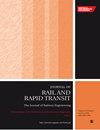Forecasting cross-tie condition based on the dynamic adjacent support using a theory-guided neural network model
IF 1.7
4区 工程技术
Q3 ENGINEERING, CIVIL
Proceedings of the Institution of Mechanical Engineers Part F-Journal of Rail and Rapid Transit
Pub Date : 2023-09-29
DOI:10.1177/09544097231203275
引用次数: 0
Abstract
Cross-ties represent a key infrastructure asset of the railroad industry. Recent research has shown that the cross-tie life is not only affected by the traditionally defined load and track design parameters but also by support condition, and in particular, support condition as represented by the condition of adjacent cross-ties. This paper builds upon the recent research and is focused on predicting a cross-tie’s future condition as a function of the changing condition of the surrounding cross-ties. As accurate cross-tie condition information becomes available from automated inspection systems, this data allows for the development of a theoretical framework for predicting cross-tie degradation and corresponding cross-tie life. This theoretical framework allows for the modeling of the interactions between adjacent cross-ties as a complex and dynamic system. Thus, the objective of this paper is to develop a model that uses theory guided machine learning framework as supported by well-defined railroad engineering relationships, such as the Beam on Elastic Foundation theory, to forecast the cross-tie condition as a function of its adjacent cross-ties and their corresponding degradation rates. The resulting model outperformed a more conventional traditional neural network model. The theory guided machine learning model showed very good correlation with actual data exhibiting an R 2 of 88.6% and an a 20 -index of 91% suggesting that the incorporation of domain knowledge into the machine learning model leads to demonstrably better cross-tie life prediction results.基于理论指导的神经网络模型对动态相邻支护交叉工况进行预测
交叉铁路是铁路行业重要的基础设施资产。近年来的研究表明,交叉杆的寿命不仅受传统荷载和轨道设计参数的影响,还受支承条件的影响,特别是以相邻交叉杆为代表的支承条件的影响。本文建立在最近研究的基础上,重点是预测交叉连接的未来状态,作为周围交叉连接变化条件的函数。随着自动检测系统提供准确的交联状态信息,这些数据可以用于预测交联退化和相应的交联寿命的理论框架的发展。该理论框架允许将相邻交叉关系之间的相互作用作为一个复杂的动态系统进行建模。因此,本文的目标是开发一个模型,该模型使用理论指导的机器学习框架,并得到定义良好的铁路工程关系(如弹性基础梁理论)的支持,以预测交叉连接状态作为其相邻交叉连接及其相应退化率的函数。由此产生的模型优于更传统的传统神经网络模型。理论指导的机器学习模型与实际数据显示出非常好的相关性,r2为88.6%,a -指数为91%,这表明将领域知识纳入机器学习模型会导致明显更好的交叉寿命预测结果。
本文章由计算机程序翻译,如有差异,请以英文原文为准。
求助全文
约1分钟内获得全文
求助全文
来源期刊

CiteScore
4.80
自引率
10.00%
发文量
91
审稿时长
7 months
期刊介绍:
The Journal of Rail and Rapid Transit is devoted to engineering in its widest interpretation applicable to rail and rapid transit. The Journal aims to promote sharing of technical knowledge, ideas and experience between engineers and researchers working in the railway field.
 求助内容:
求助内容: 应助结果提醒方式:
应助结果提醒方式:


